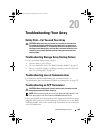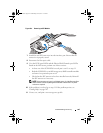
284 Troubleshooting: Your Storage Array Software
If the storage array returns to optimal status, you have completed
this procedure.
c
Examine the ethernet cables to ensure that you cannot see any
damage and that they are tightly connected.
d
Ensure that the applicable network configuration tasks have been done
(for example, the IP addresses have been assigned to each controller).
5
Ensure that the controller firmware is compatible with MDSM on your
management station. If the controller firmware was upgraded, the MDSM
might not have access to the storage array. A new version of MDSM might
be needed to manage the storage array with the new version of the
controller firmware.
If this problem exists, see the Dell support website at support.dell.com.
6
Look to see if there is too much network traffic to one or more controllers.
This problem corrects itself because the MDSM tries to re-establish
communication with the controllers in the storage array at regular times. If
the storage array was unresponsive and a subsequent try to connect to the
storage array succeeds, the storage array becomes responsive.
7
For an out-of-band storage array, look to see if management operations
are taking place on the storage array from other storage management
stations. The type of management operations being done and the
number of management sessions taking place together establish the
number of TCP/IP connections made to a controller. When the
maximum number of TCP/IP connections have been made, the
controller stops responding. This problem corrects itself because after
some TCP/IP connections complete, the controller then becomes
responsive to other connection tries.
8
If the storage array is still unresponsive, problems might exist with
the controllers.
If these problems exist, see the Dell support website at support.dell.com.
book.book Page 284 Wednesday, June 8, 2011 5:01 PM


















